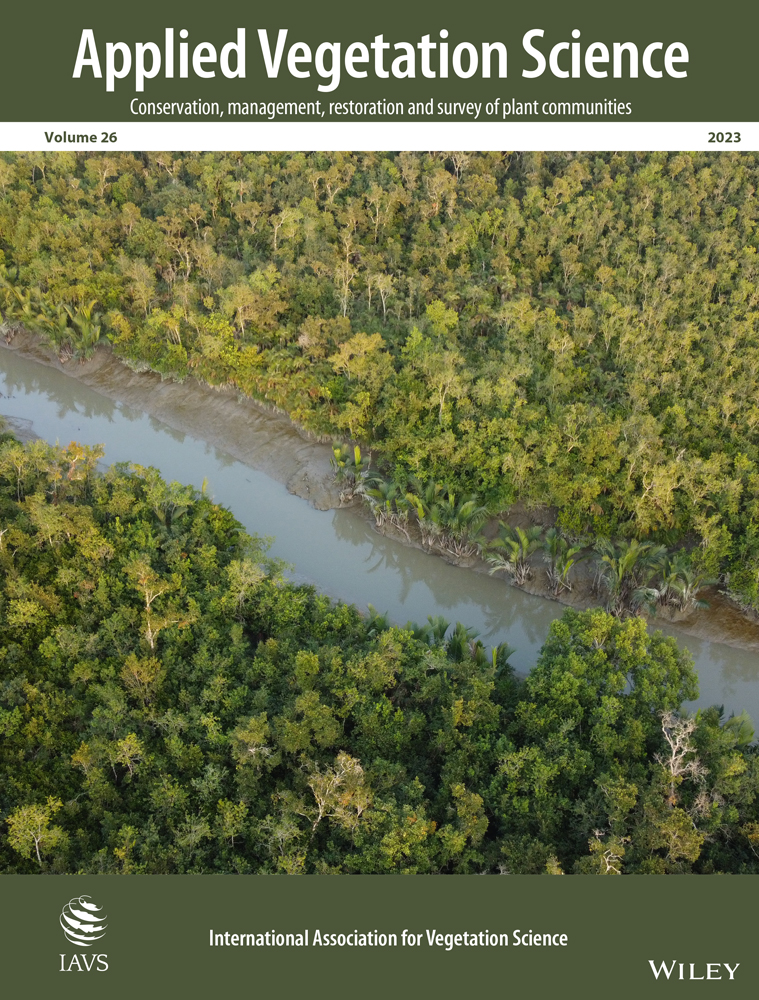Ver ítem
- xmlui.general.dspace_homeCentros Regionales y EEAsCentro Regional CórdobaEEA ManfrediArtículos científicosxmlui.ArtifactBrowser.ItemViewer.trail
- Inicio
- Centros Regionales y EEAs
- Centro Regional Córdoba
- EEA Manfredi
- Artículos científicos
- Ver ítem
Degradation influences equilibrium and non-equilibrium dynamics in rangelands: implications in resilience and stability
Resumen
Question: Plant communities are structured by both equilibrium and non-equilibrium dynamics, which interact at different spatiotemporal scales. The influence of external factors on internal regulation processes might depend on ecological state, and thus,
on system resilience. We asked if well-conserved (reference) states have higher resilience
to external factors than degraded states, considering the greater capacity for self-regulation expected of
[ver mas...]
Question: Plant communities are structured by both equilibrium and non-equilibrium dynamics, which interact at different spatiotemporal scales. The influence of external factors on internal regulation processes might depend on ecological state, and thus,
on system resilience. We asked if well-conserved (reference) states have higher resilience
to external factors than degraded states, considering the greater capacity for self-regulation expected of reference states. Location: Graminous–subshrubby steppes of northern Patagonia, Argentina.
Methods: During four years, we assessed the influence of an external factor (rainfall variability) on internal regulation processes (seedling recruitment, growth of main perennial species, and three resilience proxies) in two alternative states (one reference
and another degraded) of graminous–subshrubby steppes of northern Patagonia (Argentina). Specifically, we assessed the response of alternative states to simulated high rainfall events (irrigation).
Results: The degraded state was more sensitive to rainfall variability than the reference state. Specifically, in the degraded state the density of surviving seedlings, the growth of shrubs and Papostipa speciosa’s relative tiller production and cover increased
in response to irrigation; whereas seedling emergence and survival, and grass growth were low or even null without irrigation. Finally, resistance and elasticity were lower whereas malleability was greater in degraded than in reference states.
Conclusions: The degraded state was less resilient (low resistance and elasticity; high malleability) to stochastic weather events (in response to either increases or decreases in water availability. In contrast, the reference state had a great capacity to respond
to rainfall variability. However, demographic processes such as seedling recruitment and vegetative growth were compensated by competition and mortality, suggesting a lower sensitivity to external drivers, and thus, a greater stability. By influencing the
balance between equilibrium and non-equilibrium dynamics, degradation might affect the resilience and stability of the ecosystem. Thus, to prevent rangeland degradation, management plans should anticipate climatically favorable and unfavorable periods.
[Cerrar]

Autor
Lopez, Dardo Ruben;
Cavallero, Laura;
Willems, Priscila Mabel;
Bestelmeyer, Brandon Thomas;
Brizuela, Miguel Angel;
Fuente
Applied Vegetation Science 25 (3) : e12670. (July/September 2022)
Fecha
2022-09
Editorial
Wiley
ISSN
1654-109X
Documentos Relacionados
Formato
pdf
Tipo de documento
artículo
Proyectos
(ver más)
INTA/PATNOR-1281101/AR./Aportes para el desarrollo de cordillera y precordillera.
INTA/PNPA-1126074/AR./Desarrollo, Integración y transferencia de tecnologías para manejo sustentable de servicios de la vegetación natural para fines ganaderos.
INTA/PNBIO-1131044/AR./Genómica aplicada a estudios de ecología molecular y diversidad genética.
INTA/PNNAT-1128051/AR./Gestión de biodiversidad, servicios ecosistémicos, impactos y resiliencia socio agroambiental en sistemas productivos.
INTA/CORDO-1262204/AR./Gestión de la innovación en el territorio del arco noroeste de la provincia de Córdoba.
INTA/PNAGUA-1133023/AR./Tecnologías para la gestión del agua en cuencas rurales.
Palabras Claves
Derechos de acceso
Restringido
 Excepto donde se diga explicitamente, este item se publica bajo la siguiente descripción: Creative Commons Attribution-NonCommercial-ShareAlike 2.5 Unported (CC BY-NC-SA 2.5)
Excepto donde se diga explicitamente, este item se publica bajo la siguiente descripción: Creative Commons Attribution-NonCommercial-ShareAlike 2.5 Unported (CC BY-NC-SA 2.5)


